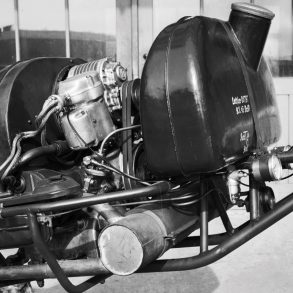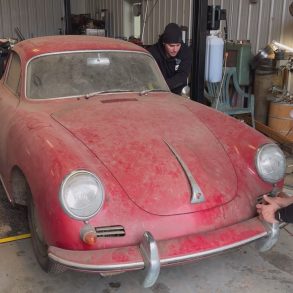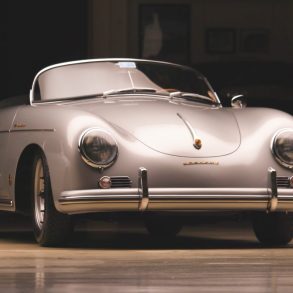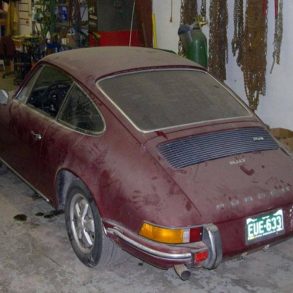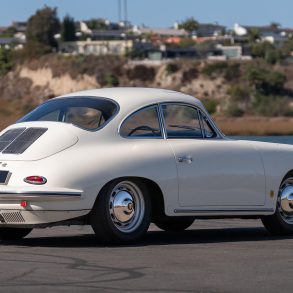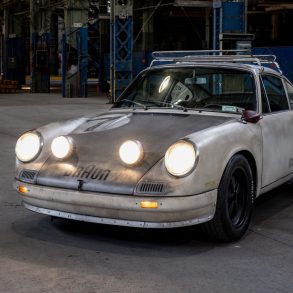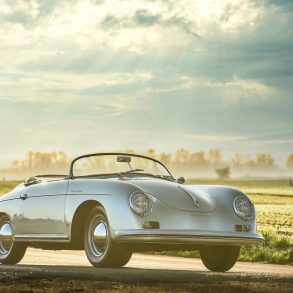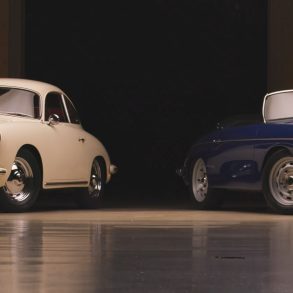The Audiobahn E7: Porsche in the 80s
Welcome to The Audiobahn, the Stuttcars.com podcast focused on all things Porsche. In our first series, we’re exploring the history of venerable 911: its history, origins, achievements, and future.
The Audiobahn E7: Porsche in the 80s
Read the Podcast Transcript
B: Hey everyone and welcome to the Audiobahn, your Porsche podcast. I’m Braden Clark and this is Chris Carnduff. In this podcast, we dive into the really well-written articles on stuttcars.com, pull out their content, and turn them into these informative and hopefully entertaining podcasts. So in this series, we’re going through the history of the Porsche 911; Porsche’s most iconic car. We started all the way back at the 356 and the 901 and we’ve worked all the way up until the last episode where we talked about the 935, the absolute Mammoth of an 800 horsepower machine. Chris, what are we diving into this week?
C: We’re getting into the second generation. We’re on to the 964 911.
B: Cool, so you excited?
C: Oh, I’m ready are you ready?
B: I’m absolutely ready, let’s go. And we’re back.
C: Here we go.
B: With drinks. Chris, what are we talking about? We’re talking about the second generation this week.
C: We’re talking about the second generation this week. We’re talking about the… well we’ll get there. You know the 1980s were a really awesome time, Brayden. We have the Soviet Bloc seemed like it was getting weaker and weaker every year, the Oilers were the best hockey team in the world and Rush had arguably their best decade of music recording.
B: This is true.
C: But you know the 80s were also a really bad time, Brayden, because there were really horrible economic policies happening all over the West, the Oilers were the best team in the world and Rush had maybe arguably their worst recording decade ever.
B: Depends on who you’re talking to on the rush side. I mean moving pictures is great.
C: Man, I love signals. So if you’re talking to me, best decade. But hey, I digress. The point is that the 80s were a time of many perspectives and while all that was going on adding to the absolute wildness of the 80s was automotive technology. There was a ton of Technology coming forward, like a ton of it. Unfortunately, this is mostly remembered by people as being really awful Digital dashboards that have always seemed to fail, really crappy diesel technology, which by the way wasn’t crappy, it was just that American auto manufacturers did their darndest to make sure that diesel failed in North America. And of course, really horrible Transmissions. But within all that turmoil of the good and the bad, there was Porsche. Porsche was in kind of an interesting place during the 1980s. The 911 was still in its first generation, technically, which started way back in 1963.
B: That’s a long generation.
C: It’s a wildly long Generation. I don’t know if there’s a really good analog for it, for just how long it went on for, but it was long man, like by the mid-80s it had been around for 20 years. In one generation. You can say there’s the G Series and the 930, but even by the mid-80s, the 930 had started in 1972, you know, by 1980 it was eight years old. By the mid-80s it was over 10 years old. This was technology from yesteryear by the time the mid-80s came around.
B: It’s long in the tooth at this point.
C: Certainly, and while all this technology is stepping forward, you know, like turbo technology is getting really progressed throughout the 80s. Thanks, in no small part, to the crazy Group B rally that FIA had for like two years, which is mind-boggling.
B: Yeah, you were talking about that earlier.
C: I just couldn’t help but mention it, like it’s crazy. If you never looked into Group B, this isn’t the time to talk about it but please, please go look into Group B because it is, it’s nuts. While all this technology is getting pushed forward, Porsche and the 911 is just sitting there and Porsche, you know, is going through a few different CEOs during the 80s and they’re coming out with new cars too. Right, like the 944 is coming out. So by the time the late 80s come around, people are going okay well you know the 911, it’s kind of coming to its natural end. It had a good run, it’s been here for over, by the late 80s, you know 25-26 years. So they’re going okay, you know a quarter of a decade, that’s pretty good. Time for us to move on to something else.
B: Yeah exactly.
C: Nope. Porsche says no way, we’re keeping this around, and here comes the second generation. The 964. Here we go. Do you mind reading out some quick stats for us?
B: I can absolutely read out some quick stats. I do know off the top of my head that this thing was sporting a lovely 3.6 liter and I believe it was giving us 250 brake horsepower, 250 brake horsepower at 6,100 RPMs, generating 229 pound-feet of torque at 4,800 RPM, and giving us beautiful top speed of 162 mph and a 0-60 of 5.6. All in something that weighs 3,252 pounds. So definitely heavier than the 935.
C: Definitely. Yeah Especially if you go to the user models of the 935 that you can drive this on the actual Road, not just the technically road-legal models. The new second generation is a completely different car.
B: Cool.
C: The body looks the same but the architecture is entirely different and it has a ton of that new technology thrown into it. So let’s talk about that new technology. First of all, you remember that big whale tail spoiler that was on.
B: It’s a beautiful thing.
C: Yeah throw it out, gone. Now we have a retractable spoiler.
B: Nice.
C: Yeah, and you know what, it retracts by itself. Fancy.
B: This is high-tech stuff.
C: It certainly is. Also, you know how the 911 was always a manual. This is kind of crazy, it wasn’t until the last year of the G Series, that you could get a five-speed manual. It was only four speeds leading to that. But it was pretty well always a manual you know. No longer.
B: Oh my goodness.
C: No, now you can also get a Triptronic automatic transmission. Yeah, so those are the kinds of automatic transmissions, of course, where you can you’re driving an automatic but you can use paddle flippers or you know you can go down here you can move in between your gears manually. So that was introduced in the new 946 in 1989. Porsche did indeed include all the technology, but they did, as I said earlier, completely overhaul the car. Let’s talk about the three big notable changes that are gonna influence us for the rest of this generation. Number one: they switched their flywheel. That’s it, they switched their flywheel.
B: Beautiful, how and why?
C: They switched to a dual-mass flywheel and I won’t get into the specifics of that because the amount of springs involved in a dual-mass flywheel is ridiculous, but suffice it to say, or simply put, it’s a flywheel with two separate body masses that rotate and kind of independently, but also with each other, so it can continue the inertia more smoothly. Which means that you get a far more even Power Band. So instead of each explosion causing the flywheel to jerk slightly, which our human eyes just can’t see whenever it’s rotating so fast, but the car can feel and the engine can feel, by putting that dual Mass flywheel, boom your power band gets smoothed out and you know Bob’s your uncle. You’re able to do a lot more, a lot more efficiently.
B: Cool love that.
C: Great. And the second big thing. Hallelujah, they finally did it, they changed their suspension geometry.
B: I love how much you love that.
C: It’s a big deal.
B: It is, no it’s absolutely a big deal.
C: I remember a side as anecdote, I remember my second ever car was a 1990 Mazda Miata and I thought that the coolest thing about it was that it had a dual a-arm suspension setup. Yeah.
B: Chris I love you. You know what I can’t talk, I mean my second car ever was a Dodge Neon. So nowhere near as cool as you. And I think that thing had just cement bricks for suspension, so you’re still cooler than that.
C: Oh thank you.
B: You’re welcome. I appreciate that. But yeah geometry man. So what they did was they replaced the rear trailing arm suspension that they had been using and they replaced that with the extraordinarily effective, Weissach rear axle. So the Weissach rear axle was devised in Weissach, and it was a semi-trailing arm suspension system. Again, I’m not going to get into the specifics of it but the full trailing arm suspension system, whenever you broke, like whenever you hit the brakes, relative to the body, the wheels would drop back. Right, so it’s not actually what’s happening, but if you’re looking at it relative to the ground, the wheels are staying, are still moving forward and it’s the whole body that’s moving ahead of them. But for the sake of simplicity, we’re talking in the frame a reference of the body the wheels move back. So with the trailing arm suspension when the wheels move back they also toe out. Just because of where their bushings are and how their bushings operate, they toe out a little bit. Whenever your wheels toe out that means your car kind of wants to dance along with it and this is a problem because it makes your car very unstable. This is a problem whenever you have an engine way in the back behind the rear axle. So they changed that and this new Weissach rear axle, instead of having replaced one bushing with a linkage, and all of a sudden what happened was whenever you broke instead of it Towing out it towed in. Gotcha. So whenever your wheels Tow in they want to track toward the center of the vehicle, which makes it a far more stable ride. Which means you can actually take a corner. So in the oversteer-happy world of the 911, having this new rear suspension changed everything. The car has now come into the modern world. And beyond that, they do the thing. You know how I was talking about Group B and how Group B Rally put in turbo-chargers. They didn’t just put in turbochargers, they also popularized all-wheel drive systems, because all of a sudden with an all-wheel drive system you’re able to put down all your power, all at once, to all four wheels. You get great traction, you get better handling and better responsiveness. Everything’s better. In 1989 with the 964 911, they introduced the 911 Carrera 4, which is the one that you read out the stats for. The four parts Carrera four, referred to the all-wheel drive system that was now on the 911.
B: Okay so we’ve got a new flywheel that’s smoothing out our power band, we’ve got new suspension geometry that’s giving us more control as we go into and around corners, and then all-wheel drive.
C: You got it.
B: So we’ve got some substantial improvements in this new generation.
C: Yeah and not just that, like you said earlier, we’ve gone from a three litre engine to a 3.6 litre engine. Everything about this car is totally different. It’s got more power, it can handle better, it can put down the power better, it’s a totally different car than the 930, it’s the 946. We’re into the next thing and not just the 946 Carrera 4, which is the one that you know we read out earlier, but all the different sub-variations within that and all the different Limited Editions and like the Coupes and the RS and the S and the Turbo. There are a ton of different 946s and this generation, this series, only lasts for like five years, but we’re gonna get a lot of mileage out of it. So this is episode one of 946, there are two more to go after this.
B: In a five-year period.
C: In a five-year period.
B: That’s some substantial Porsche.
C: Yeah absolutely, it’s a lot to talk about. Cool.
B: Okay, so we’ve just talked about the 946 and the next two episodes in the series are gonna be focusing on the variants of the 946. Specifically, you were mentioning stuff happening in 1992, that’s a pretty big year we’re gonna talk about right?
C: Big Year. Big year. Lots and lots of variations. Lots of little interesting limited editions. We are gonna talk a lot about 1992.
B: Okay sweet. Well, guys thank you for joining us. I’m Brayden, this is Chris. If you want to learn anything else about Porsche, head over to stuttcars.com. They have the biggest collection of some of the most well-written Porsche articles in the world. They’ve got a really good membership program. You can access most things for free but for five dollars a month, you can get access to some really premium content and a better ad-free experience. Head over there now if you’re a Porsche fan and we will see you next week. Chris.
C: Brayden.
B: See you guys later.


